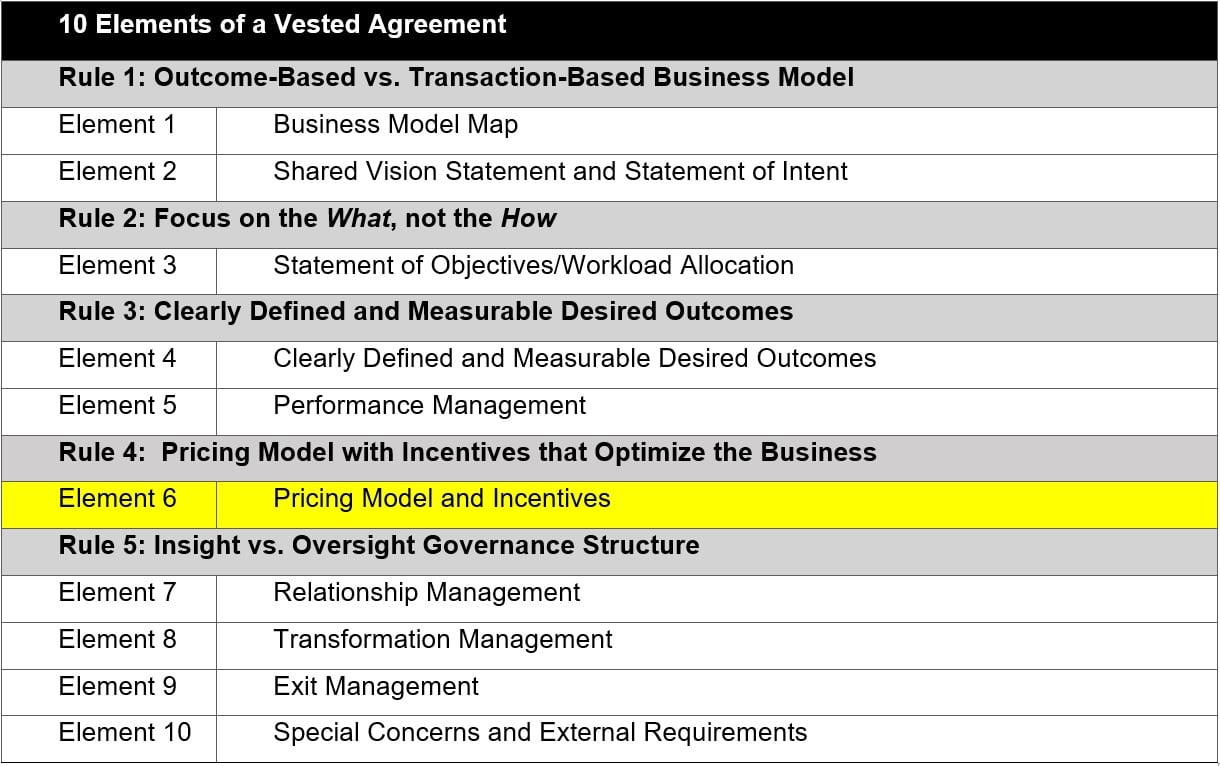Inside Supply Management Magazine
Strategic Contracts: Pricing Model Incentives Optimized for Cost/Service Trade-offs

(Editor’s Note: Inside Supply Management® Weekly recently published “Implementing a Successful Supplier Sourcing Contract,” which highlighted why strategic supplier relationships should use all the tools in the contracting toolkit. This article is the sixth in a series that explores each of the 10 elements that craft successful buyer-supplier contracts, as described in the book The Vested Outsourcing Manual. This article discusses Rule 4, Element 6 — Pricing Model with Incentives to Optimize the Business.)
By Kate Vitasek
Pricing is typically one of the top items on the table — and it can be the most complex or contentious issue — because getting pricing and the pricing model right speaks directly to an enterprise’s bottom line and ultimate success.
When Element 6 is implemented successfully, the parties create a paradigm shift because the Vested approach ties the service provider/supplier profitability to meeting mutually agreed on desired outcomes. This ultimately creates a win-win relationship where the buyer and supplier destinies are linked. A win for the supplier is a win for buyer — and vice versa.
Unfortunately, many procurement professionals take a traditional approach, in which the focus is only on price — and getting the lowest possible transaction price (price per hour, per widget, per call) — rather than creating a pricing model that reflects the business’s true nature.

A key feature of a Vested pricing model is the use of a collaborative and transparent approach where the parties jointly create a flexible pricing model with incentives rather than a price or cost schedule. Keep in mind the tip from the first article in this series on Vested Rule 1 — focus on outcomes, not transactions — so the Vested methodology pays for outcomes, not transactions.
Inherent in this model is a reward for service providers to invest in processes, service or associated product that will generate returns in excess of agreement requirements. Higher profits are not guaranteed — what business model can claim that? — but Element 6 provides service providers with the authority, autonomy and tools to make strategic investments in processes and product reliability that can generate a greater return on investment than a conventional cost-plus or fixed-price-per-transaction agreement might yield.
Incentives are a major part of this mix because service providers are taking on risk to generate larger returns on investment. An incentives package delivers the most commercially efficient method of maintaining equitable margins for all parties for the duration of the relationship.
The term “model” is used because a good pricing model enables the parties to manipulate the underlying pricing assumptions, allowing them to model the outputs relative to the input components. Common pricing model components include:
●Total cost build-up and best-value assessment
●Underlying financial and operational assumptions
●Risk factors and allocations
●Desired compensation method (fixed price, cost plus or hybrid)
●Margin-matching triggers and techniques
●Contract duration
●Incentives.
When properly structured, a Vested pricing model should generate returns in excess of target margins for both parties when the parties achieve the desired outcomes. The parties form a partnership: They create a commercial pricing structure and associated budgets that equitably allocate risks and rewards with the purpose of realizing mutual gains for the duration of the agreement.
Chapter 6 of The Vested Outsourcing Manual details how to take the theory and put it into practice using the following 12 steps:
●Form the team
●Establish guardrails
●Document input assumptions
●Identify total ownership costs and perform a best-value assessment
●Perform risk assessment and allocate risks
●Agree on the compensation model
●Determine contract duration
●Complete the pricing model and establish prices
●Test the model and agree on the baseline
●Define margin-matching triggers and techniques
●Agree on incentives
●Document deployment processes.
Following the 12 steps enables the parties to create a fair and balanced Vested pricing model that’s designed to create value, not just exchange value for transaction.
The next articles in this series cover the four elements associated with Vested Rule 5: establish an insight, rather than oversight, governance structure. Up next is Element 7, on implementing a collaborative relationship management framework.
Kate Vitasek is an international authority on the Vested business model for highly collaborative relationships. She is the author of six books on the Vested model and a faculty member at the University of Tennessee in Knoxville, Tennessee.

